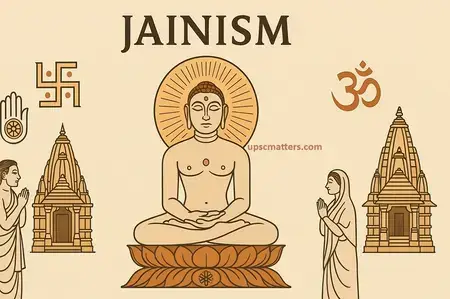Jainism for UPSC preparation holds significant importance in both the Prelims and Mains stages of the Civil Services Examination. As one of the major religious and philosophical traditions that emerged in ancient India, Jainism offers deep insights into India’s spiritual, cultural, and ethical landscape. From the teachings of Mahavira and the principle of non-violence to its contributions in art, architecture, and literature, Jainism is a vital topic under GS Paper I (History and Culture) and Ethics Paper (GS IV). This article provides concise, point-wise, and exam-focused notes on Jainism to help aspirants grasp the core concepts and facts effectively.
Origin and Background of Jainism
- In the sixth century BC, Jainism emerged as a result of widespread opposition to the formalized ritualism and hierarchical structure of the Vedic religion.
- It is a Śramaṇa tradition, like Buddhism, reacting against ritualistic Brahmanism. Sramana’ is a Sanskrit word that denotes an ascetic or monk.
- The word “Jaina” comes from “Jina”, meaning conqueror or victor over desires.
- Jainism is one of the religions whose origin can be traced back to the twenty four teachers (tirthankaras – ones who establishes a path or ford), through whom their faith is believed to have been handed down.)
Historical Background of Jainism for UPSC
- Adinath/Rishabhdev: The first Tirthankara (supreme preacher) and establisher of the Ikshvaku dynasty.
- Ajita: The second Tirthankara
- Neminatha: the twenty-second Tirthankara
- Parsvanatha: According to Jaina tradition, the twenty-third Tirthankara, Parsvanatha, was the son of King Asvasena of Varanasi and Queen Vama.
- Parsvanatha believed in the eternity of ‘matter’.
- The followers of Parsvanatha wore white garments.
- Thus, it is clear that even before Mahavira, some kind of Jaina faith existed.
- Mahavira: The twenty-fourth Tirthankara was Vardhamana Mahavira.
Mahavira and his life
The 24th Tirthankara was Vardhamana Mahavira.
- Birth: Born in Kundagrama (Basukunda), a suburb of Vaishali (Bihar), in 540 BC.
- Parents: Father Siddhartha (head of the Jnatrikas, a Kshatriya clan) and mother, Trishala, a Lichchavi princess.
- Spouse: Yashoda
- What made Vardhaman Mahavira take up asceticism?
- At the age of thirty, Vardhamana left his home and became an ascetic.
- In the 13th year of his asceticism, at the age of 42, he attained the ‘Supreme Knowledge’ (Kaivalya).
- Titles: He was later known as ‘Mahavira’ (the supreme hero) or ‘Jina’ (the conqueror). He was also hailed as ‘Nirgrantha’.
- Preachings: For the next thirty years, he moved from place to place and preached his doctrines in Kosala, Magadha, and further east.
- Patronage: He often visited the courts of Bimbisara and Ajatasatru.
- Death: He died at Pawa (near Rajagriha) in Patna district at the age of 72 (468 BC).
Pancha Mahavratas in Jainism
| 4 doctrines advocated by Parsvanath | 5th Doctrine added by Mahavira |
| Ahimsa: do not commit violence Satya: do not tell a lie Asteya: do not steal Aparigraha: do not hoard | Brahmacharya: celibacy |
Triratna (Three Jewels of Jainism)
| Ratnatraya/three jewels (three principles required to be observed to attain Moksha/Nirvana) | ||
| Samyak Darshan: Right belief | Samyak Gyan: Right knowledge | Samyak Charitra: Right action |
8 Auspicious Symbols of Jainism
Jainism has several important symbols that hold significant meaning for its followers. Here are some of the key symbols of Jainism:
- Swastika – It signifies the peace and well-being of humans.
- Nandavarta – It is a large swastika with nine endpoints.
- Bhadrasana – A throne is said to be sanctified by the Jaina’s feet.
- Shrivatsa – A mark manifests on the chest of Tirthankara’s image and signifies his pure soul.
- Darpana – The mirror which reflects the inner self.
- Minayugala – A couple fish which signifies the conquest over sexual urges.
- Vardhamanaka – A shallow dish is used as a lamp, which shows the increase in wealth, due, and merit.
- Kalasha – A pot filled with pure water.
Jaina Council
First Jain Council (300 BC) | Second Jain Council (512 AD) | |
| Venue | – Pataliputra (Bihar) | – Vallabhi (Gujarat) |
| Presided by | – Sthulbhadra | – Devardhigani Kshemasarmana. |
| Patronage | – Chandragupta Maurya | -NA- |
| Outcome | – Sthulabhadra divided the Jaina canon into 12 ‘angas’ or sections, and they were compiled. | – New additions were made in the form of “upangas” or minor sections. |
Purvas and Angas
| Term | Meaning | Number | Status | Content Focus |
| Purvas | Ancient texts | 14 | Lost | Jain philosophy, karma, metaphysics |
| Angas | Canonical limbs | 12 (1 lost) | 11 available | Rules, ethics, doctrines, narratives |
Five types of knowledge in Jainism
According to Jainism, knowledge is the quality of the soul. Understanding and acquiring knowledge are attained through pramana (instruments of knowledge) and naya (points of view).
- Mati Jnana: Perception through the activity of sense organs, including the mind.
- Sruta Jnana: Knowledge revealed by the scriptures.
- Avadhi Jnana: Clairvoyant perception.
- Manahparyaya Jnana: Telepathic knowledge
- Kevala Jnana: Temporal knowledge or omniscience.
Doctrine of Anekantavada and Syadvada
Syadvada (Theory of Judgement)
- The Jain view that all our ordinary knowledge is necessarily partial, always relative to some particular point of view and particular aspects of objects, is known as Syadvada.
Anekantavada
- According to this doctrine, ultimate truth and reality is complex and has multiple aspects.
- Anekantavada has also been interpreted to mean- non-absolutism, intellectual ahimsa, religious pluralism, and rejection of fanaticism.
Nayavada: Theory of partial standpoints to understand complex reality.
Jainism sects Digambara and Svetambara
The Jain order has been divided into two major sects: Svetambara and Digambara.
Reason for division: The division occurred mainly due to famine in Magadh, which compelled a group led by Bhadrabahu and Chandragupta Maurya to move to South India (Shravan Belgola) in 298 BC.
- The leader of the group that stayed back at Magadha was of Sthulbhadra.
- During the 12 years of famine, the group in South India stuck to the strict practices, while the group in Magadha adopted a laxer attitude and started wearing white clothes.
During later years, further splits took place among both sections, the most important of them being one that renounced idol worship altogether and devoted itself to worshipping the scriptures.
- They were called the Terapanthis among the Svetambaras and the Samaiyas among the Digambaras. (This sect came into existence about the sixth century CE).
| Sects | Digambaras | Svetambaras |
| Led by | Bhadrabahu | Sthulbhadra |
| View on Clothing | – They do not wear clothes, as this sect believes in complete nudity. – Female monks wear unstitched, plain white sarees and are called Aryikas. | – They wear simple white clothes. |
| Question on women | – They believed that women could not be Tirthankaras and Malli was a man. | – They believe that Tirthankaras can be men or women. |
| Follow the teachings of | – Mahavira, that is, “Pancha Mahavratas”, to attain Kaivalya. | – Preachings of Parshvanatha, that is, only four restraints (except Brahmacharya). |
| Follow the Jain literature | – Prakrit Suttapahuda of Kundakunda. | – Believed in the validity and sacredness of the twelve angas and sutras. |
| Food for omniscient | – Once a saint becomes a kevalior Kevala-jnani,that is, omniscient, he needs no morsel of food. | – This view is not acceptable to the Svetambaras. |
| Idols of Tirthankaras | – They represent the idols of Tirthankaras as nude. Unadorned and with downcast eyes in a contemplative mood. | – Depicts the idols of Tirthankars as wearing a loin-cloth adorned with jewels and with glass eyes inserted in the marble. |
Jain Literature
- Agamas – Jain canonical texts in Prakrit.
- Tattvartha Sutra by Umaswati/Umasvami – first Jain text in Sanskrit.
- Other texts: Kalpasutra (biography of Mahavira), Niyamasara, Samayasara.
Jain Architecture and Art
- Mount Abu (Dilwara Temples) – marble temples, Rajasthan.
- Shravanabelagola (Karnataka) – Statue of Bahubali (Gommateshwara).
- Palitana temples (Gujarat), Ellora Caves (Maharashtra), etc
Jain Philosophy and Beliefs
- Universe is eternal and uncreated.
- No belief in a creator God.
- Two types of substances:
- Jiva (living soul)
- Ajiva (non-living matter)
- Karma is a physical substance, which binds the soul due to desires and actions.
- Liberation (Moksha) is achieved by destroying karmic bonds.
- The idea of God: He believed that the world was not created by any supreme creator. The world functions according to an eternal law of decay and development.
- View on Vedas: He rejected the authority of the Vedas and objected to Vedic rituals and the supremacy of the Brahmanas.
- Anuvratas: A code of conduct was prescribed for both householders and monks. To avoid evil karma, a householder had to observe the five vows (in their limited nature).
- Jainism believed that the monastic life was essential to attaining salvation, and a householder could not attain it.
- A monk had to observe certain strict rules and abandon worldly possessions.
- The idea of soul and matter: Mahavira believed that soul (jiva) and matter (ajiva) were the two basic existing elements.
- According to him, the soul is in a state of bondage created by desire accumulated through previous births.
- The liberated soul then becomes ‘the pure soul.” He thought that all objects, animate and inanimate, had a soul.
- He believed that they felt pain or the influence of injury.
- The idea of Moksha: According to Jainism, man is the creator of his own destiny, and he could attain ‘moksha’ by pursuing a life of purity, virtue, and renunciation.
- He advocated a life of severe asceticism and extreme penance to attain ‘nirvana’ or the highest spiritual state.
To read about Buddhism- https://upscmatters.com/buddhism-a-complete-guide-for-upsc-history/
For Comparison between Jainism Vs Buddhism Vs Vedic Civilization
If you found this helpful, you might also like these articles:
📌 [https://upscmatters.com/indus-valley-civilization/ ]
📌 [https://upscmatters.com/buddhism-a-complete-guide-for-upsc-history/]
They cover key concepts that will boost your preparation! 🚀
📢 Stay Updated with the Best UPSC Resources!
Join our Telegram Channel for:
✅ Daily Current Affairs
✅ Important Notes & PDFs
✅ Answer Writing Tips
✅ Strategy & Motivation
📲 Click the link to join now: [https://t.me/upscmatters] or [https://t.me/ramsirnotes]
Don’t miss out on valuable updates! 🚀


2 thoughts on “Jainism for UPSC: Complete Notes on Origin, Philosophy, Sects, Literature, and Architecture””